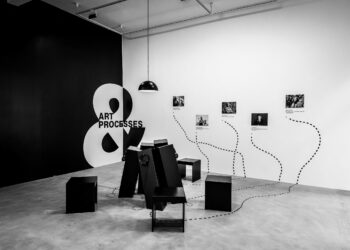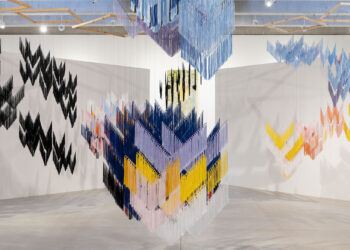ART AFRICA speaks to Sara Raza, Guggenheim UBS MAP Curator, Middle East and North Africa – who gives us insights into her curatorial practice and contemporary artistic practices from the Middle East, North Africa and the region’s diaspora.
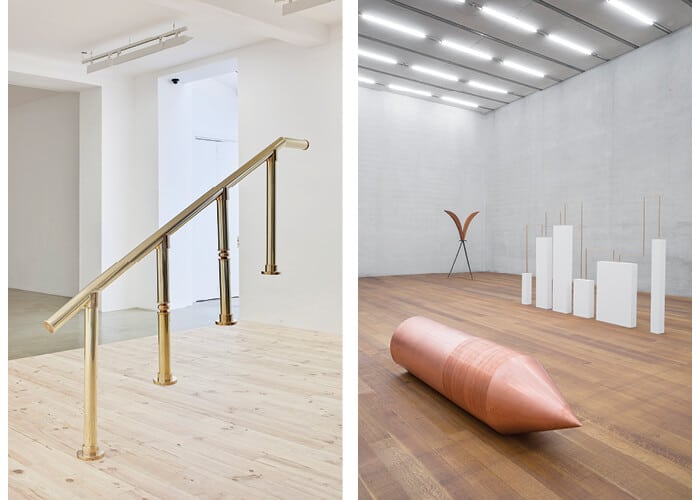 LEFT TO RIGHT: Hassan Khan, Bank Bannister (Bannister Bank), 2010. Brass, 209 x 206 x 22 cm, edition 1/3. Solomon R. Guggenheim Museum, New York, Guggenheim UBS MAP Purchase Fund 2015.94 © Hassan Khan; Iman Issa, Heritage Studies no. 10, 2015. Copper, aluminum, and vinyl, 55 x 235 cm. Edition 1 of 3. Solomon R. Guggenheim Museum, New York, Guggenheim UBS MAP Purchase Fund © 2015.91. Iman Issa. Installation view: Iman Issa: ‘Heritage Studies,’ Pérez Art Museum Miami, April 2, October 4, 2015. Photo: Studio LHOOQ. All images courtesy of the Solomon R. Guggenheim Museum, New York.
LEFT TO RIGHT: Hassan Khan, Bank Bannister (Bannister Bank), 2010. Brass, 209 x 206 x 22 cm, edition 1/3. Solomon R. Guggenheim Museum, New York, Guggenheim UBS MAP Purchase Fund 2015.94 © Hassan Khan; Iman Issa, Heritage Studies no. 10, 2015. Copper, aluminum, and vinyl, 55 x 235 cm. Edition 1 of 3. Solomon R. Guggenheim Museum, New York, Guggenheim UBS MAP Purchase Fund © 2015.91. Iman Issa. Installation view: Iman Issa: ‘Heritage Studies,’ Pérez Art Museum Miami, April 2, October 4, 2015. Photo: Studio LHOOQ. All images courtesy of the Solomon R. Guggenheim Museum, New York.
ART AFRICA: The Guggenheim UBS MAP Global Art Initiative is an ambitious project now in its third iteration. What was your point of departure when you started the process of curating ‘But a Storm Is Blowing from Paradise: Contemporary Art of the Middle East and North Africa,’ and what are some of the main themes?
Sara Raza: I am interested in the conceptual capacity of geometry as a tool to illuminate ideas around origins and truth. Geometry is a branch of the mathematical thinking sciences and I was very interested in probing ideas around logic that stem from mathematics, especially when exploring a region that is by-and-large a British and European construct. Stemming from that I explored four main themes; ideologies of architectures and how architecture was used as both a formal and informal device in nation building; the zigzagging between histories and how the past effects the contemporary moment, creating a space that oscillated between the two; the physical and metaphorical idea of ‘migratory footprints’ – of people and ideas – and their subsequent impact and lastly, the conceptual value of smuggling or contraband as a means of recovering meaning in hidden or unrecorded histories and ideas.
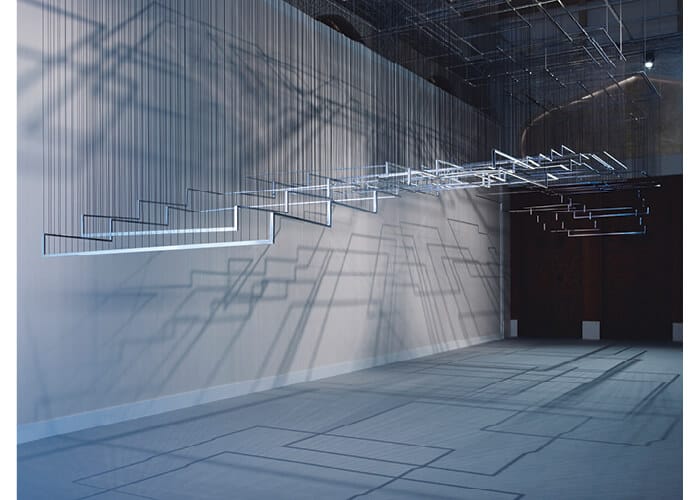 Nadia Kaabi-Linke, Flying Carpets, 2011. Stainless steel and rubber, 420 x 13 x 340 cm. 2/2 Edition (First edition commissioned by the Abraaj Group Art Prize). Solomon R. Guggenheim Museum, New York, Guggenheim UBS MAP Purchase Fund 2015.92 © Nadia Kaabi-Linke. Installation view: The Abraaj Group Art Prize, Madinat Jumeirah, Dubai, March 16-19, 2011. Photo: Thomas Brown.
Nadia Kaabi-Linke, Flying Carpets, 2011. Stainless steel and rubber, 420 x 13 x 340 cm. 2/2 Edition (First edition commissioned by the Abraaj Group Art Prize). Solomon R. Guggenheim Museum, New York, Guggenheim UBS MAP Purchase Fund 2015.92 © Nadia Kaabi-Linke. Installation view: The Abraaj Group Art Prize, Madinat Jumeirah, Dubai, March 16-19, 2011. Photo: Thomas Brown.
You said that “The exhibition’s artworks also embed numerous proposals – we might think of them as ‘conceptual contraband’ – that contradict the mass media’s highly politicised representation of the Middle East and North Africa.” Why was highlighting this so important to you?
Creating alternative avenues into what constitutes as the real was very important in the making of this exhibition and collection. We are bombarded daily with a very specific visual rhetoric of war and conflict that I wanted to intentionally avoid within this exhibition. I was seeking a more poetic analysis or reading of a region and artists who are not at all defined or driven by a purely political narrative. The use of conceptual contraband became a poetic strategy in which I was able to weave in ideas and artworks that were multilayered and were quite literally smuggling in ideas from a non-didactic perspective.
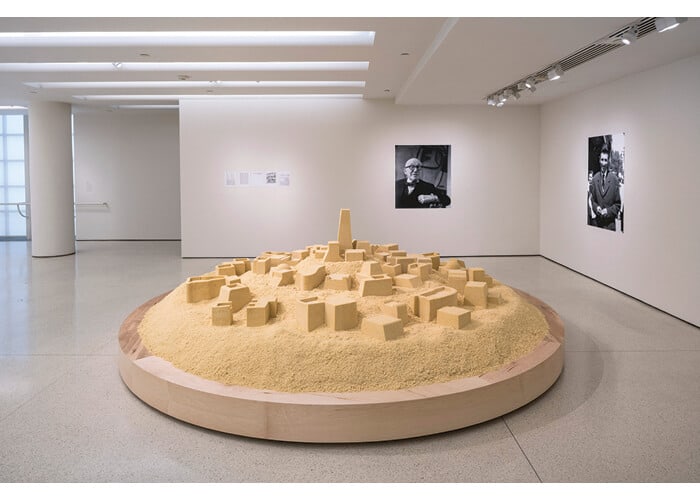 Kader Attia, Untitled (Ghardaia), 2009. Couscous, two inkjet prints, and ve photocopy prints. Edition 2/3. Solomon R. Guggenheim Museum, New York, Guggenheim UBS MAP Purchase Fund 2015.84 Installation View: ‘But a Storm Is Blowing from Paradise: Contemporary Art of the Middle East and North Africa’, Solomon R. Guggenheim Museum, New York, April 29- October 5, 2016. Photo: David Heald.
Kader Attia, Untitled (Ghardaia), 2009. Couscous, two inkjet prints, and ve photocopy prints. Edition 2/3. Solomon R. Guggenheim Museum, New York, Guggenheim UBS MAP Purchase Fund 2015.84 Installation View: ‘But a Storm Is Blowing from Paradise: Contemporary Art of the Middle East and North Africa’, Solomon R. Guggenheim Museum, New York, April 29- October 5, 2016. Photo: David Heald.
Artists in the North African and Middle Eastern regions are at the epicenter of massive change – not always positive – and many of the works in the exhibition are very challenging, both visually and conceptually. Have the dialogues and support programmes around the exhibition helped to foster positive change?
On a micro level this exhibition first launched in New York before it embarks on a regional tour next year. It was essential to focus on the global within a local context and create transnational connections between the artworks and the site so to speak. For instance, Frank Lloyd Wright (who is the architect of the Solomon R Guggenheim Museum in New York) is interwoven into this exhibition through the work of Ala Younis. Her installation, Plan for Greater Baghdad, explores historical modernist legacies and Wright’s engagement in Iraq. This links back to the architecture of the building and how Wright incorporated some of the designs for a university in Baghdad, which was never realised, into the Guggenheim’s external facade design.
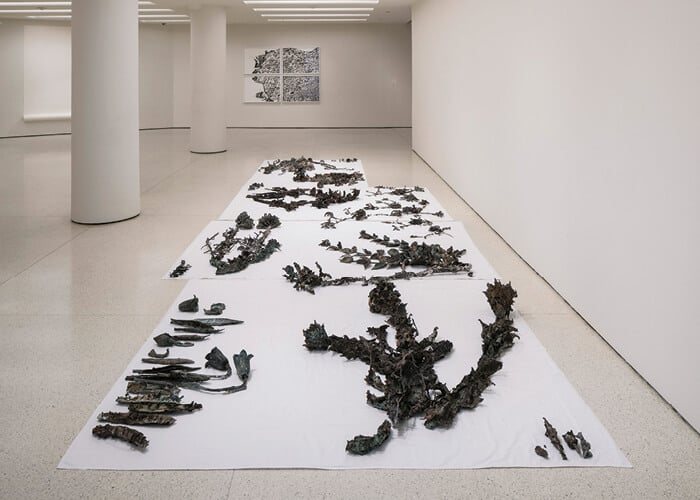 Installation View: ‘But a Storm Is Blowing from Paradise: Contemporary Art of the Middle East and North Africa’, Solomon R. Guggenheim Museum, New York, April 29-October 5, 2016. Photo: David Heald. Images courtesy of the Solomon R. Guggenheim Museum, New York.
Installation View: ‘But a Storm Is Blowing from Paradise: Contemporary Art of the Middle East and North Africa’, Solomon R. Guggenheim Museum, New York, April 29-October 5, 2016. Photo: David Heald. Images courtesy of the Solomon R. Guggenheim Museum, New York.
Crossing borders (both physically and mentally) seems to be one of the big underlying themes of the exhibition. It also seems that migration – in all its forms – is also becoming a prevalent theme for artists in general. What is your opinion on this?
The movement of people and ideas is a relevant theme in today’s society where portability has increasingly become a topic of debate. Several artists in my exhibition and in the region live and work across multiple cities and time zones. This is a conscious decision for many to operate in this way as part of their educational pursuits or artistic studio practice.
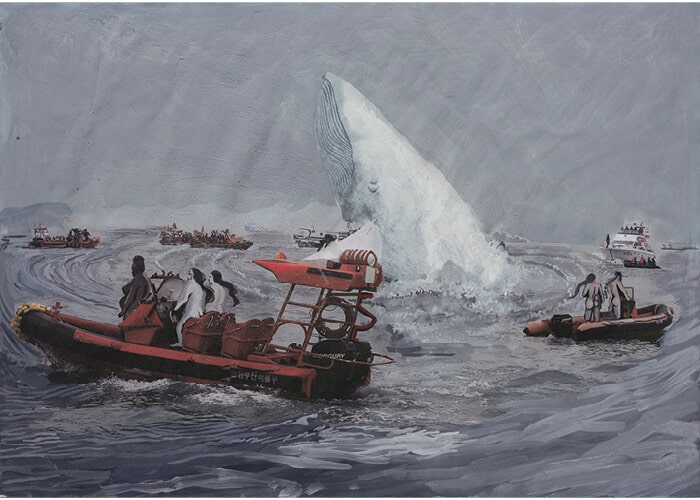 Rokni Haerizadeh, But a Storm Is Blowing from Paradise, 2014. Gesso, watercolor, and ink on inkjet prints, from 18 units to 24 hand-work, 30 x 40 cm each. Solomon R. Guggenheim Museum, New York, Guggenheim UBS MAP Purchase Fund 2015.89 © Rokni Haerizadeh. Photo: Ramin Haerizadeh.
Rokni Haerizadeh, But a Storm Is Blowing from Paradise, 2014. Gesso, watercolor, and ink on inkjet prints, from 18 units to 24 hand-work, 30 x 40 cm each. Solomon R. Guggenheim Museum, New York, Guggenheim UBS MAP Purchase Fund 2015.89 © Rokni Haerizadeh. Photo: Ramin Haerizadeh.
There is little doubt that initiatives like UBS MAP are much needed in helping to highlight contemporary art from these regions, particularly in the context of challenging the traditional views of those in the European and North American markets. How did you decide on the ‘most innovative artists’ to include. Are they artists you have worked with before?
This exhibition is of a collection and isn’t necessarily ranked according to who is the most innovative. The thematic interest was very much defined by the artists in the selection, with a few that I had a previous professional working relationship with, such as Ergin Cavusoglu, whose practice focuses on mobility and the transmission of ideas and greatly dovetails with my own curatorial practice. We have worked together in a number of international cities for festivals and exhibitions in Sharjah, Dubai, Tashkent, Shanghai and Baku.
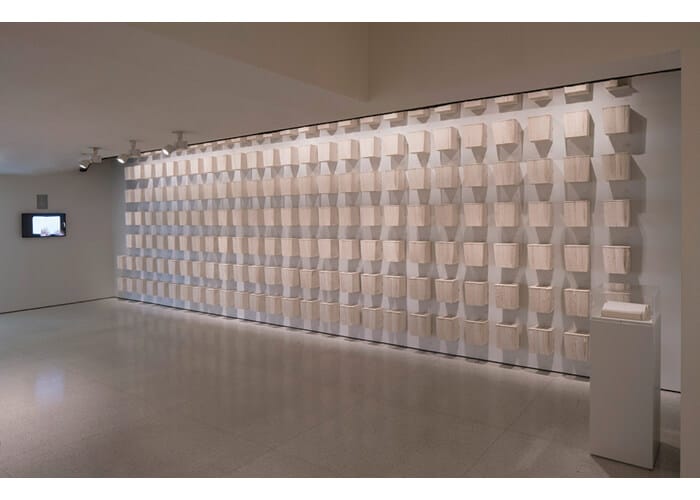 Joana Hadjithomas and Khalil Joreige, Latent Images, 2015. 354 copies of printed artist’s book, 177 metal shelves, and color video, with sound, 120 min. Solomon R. Guggenheim Museum, New York, Guggenheim UBS MAP Purchase Fund 2015.88 Installation View: But a Storm Is Blowing from Paradise: Contemporary Art of the Middle East and North Africa, Solomon R. Guggenheim Museum, New York, April 29-October 5 , 2016. Photo: David Heald.
Joana Hadjithomas and Khalil Joreige, Latent Images, 2015. 354 copies of printed artist’s book, 177 metal shelves, and color video, with sound, 120 min. Solomon R. Guggenheim Museum, New York, Guggenheim UBS MAP Purchase Fund 2015.88 Installation View: But a Storm Is Blowing from Paradise: Contemporary Art of the Middle East and North Africa, Solomon R. Guggenheim Museum, New York, April 29-October 5 , 2016. Photo: David Heald.
You (Guggenheim and UBS) state that this is a long-term collaboration which underscores a mutual commitment to supporting today’s most innovative artists by increasing visibility of their work in New York and across the globe. What has the public response been like and are there any initiatives post the exhibition to sustain this dialogue?
The works have all entered the permanent collection of the Guggenheim Museum here in New York, they will never expire, and will be available for the future generations. Already there has been interest from other museums to borrow the works for their forthcoming shows, which will expand the context and dialogue. There is also a special MAP website with online content including videos with the artists, commissioned texts and expanded artist’s pages that has a permanent space on the Guggenheim website.
‘But a Storm Is Blowing From Paradise: Contemporary Art of the Middle East and North Africa’ was on show at the Solomon R. Guggenheim Museum, New York until the 5th October 2016 before travelling to Istanbul’s Pera Museum in 2017.

